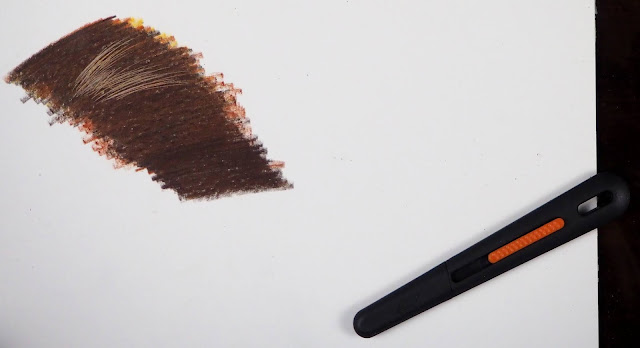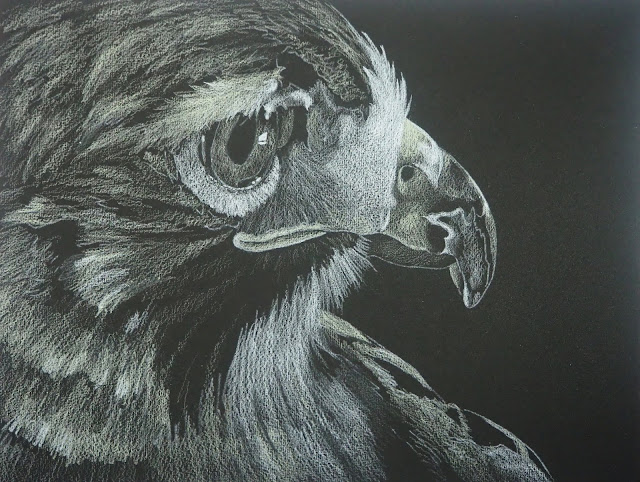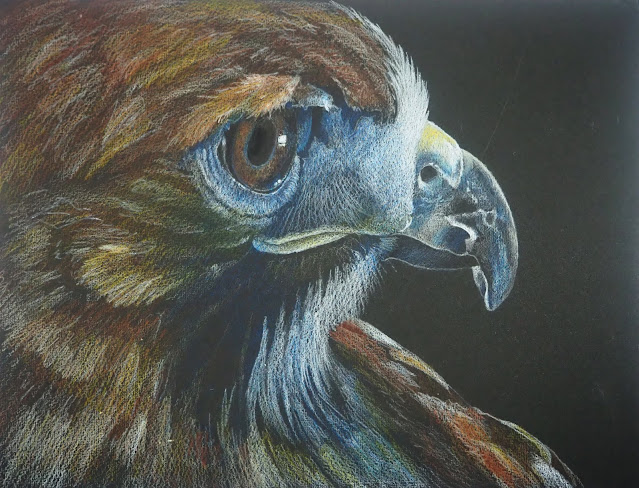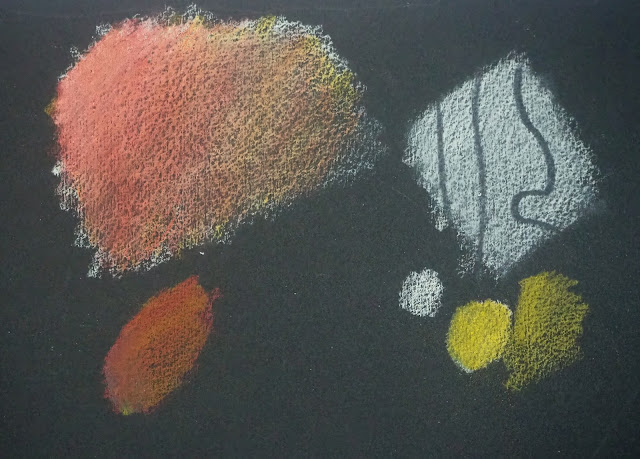I worked all over adding dark and light values, refining areas, cleaning up edges, finishing some unfinished areas, etc. The one thing I did was remove the tiny bit of flower peaking out on the upper right. I then used a grey pencil and a blending stump and stik-tak to help camouflage the stained imprint left after I erased the flower. I may need to do a tiny bit more to hide it and to the background, but it's close. I am mostly done, but will spend time looking at it overall and making tiny corrections if needed.
7/27/21
Zoom Colored Pencil Class July, 2021
I have continued to use the 6 colors (peacock blue, Copenhagen blue, yellow chartreuse, Spanish orange, Scarlet lake, pomegranate). I am continuing to layer and blend (with the drawing stump). Every so often I will use white and/or a colorless blender towards the end to further the blending and/or add some white (especially if my light areas are dirty or have too much color and won't erase). I still have more layers and smoothing to do and some areas to detail, but it's mostly completed.
7/24/21 NCBG Beginning Colored Pencil May, 2021
I have worked more on the background and a little on the blueberries. Now is the time where I will study this and make changes and additions to further refine. I will spend most of the time looking at it. I already know I am not satisfied with the stem. I need to look there first.
Another thing I will consider during this time is where to crop this piece. I do not plan to leave all of the empty space around it.
7/24/21
NCBG Beginning Colored Pencil May, 2021
I worked on the stem and parts of the blueberries that were incomplete or not started yet. I also used Peacock blue with a little Copenhagen blue to start a background. I added the background because I have several stains on the white paper. I shade the peacock, blend with a drawing stump, erase for some light areas and add Copenhagen and more peacock for darker areas and use the blending stump again.
I did the next step on the bottom part of the background compared to the photo above this one. I blended, used the eraser to make light areas, added some Copenhagen to darken in some areas, and blended again.
I will finish the background. After that I enter the final part of the process. I set this up in a place that I can look at it to refine and make corrections. This part of the process usually takes weeks but can take months (especially if the piece had some struggles).
Notice the more layers of pencil and blending the smoother it gets.
Zoom Colored Pencil Class July, 2021
Texture on the black paper using the slice utility knife (a ceramic knife). I have found that for this to show up and not damage the surface it needs to be coated with a good layer of colored pencil.
The slice utility knife (blade retracted) and the texture on white paper.
Texture on white paper.
Before class I added light layers of yellow chartreuse, Spanish orange and pomegranate (cool red).
This is how it looks after layers of the warm and cool yellows, warm and cool reds, purple blue and green blue. I have shaded and blended the layers with a clean blending stump (clean it on sandpaper). I have also used the side of a pencil top eraser to lighten areas. The eraser is used like a drawing instrument to remove pencil from light to dark by varying the pressure as I erase. I also use my Tombow Mono Zero erase for edges and small areas. I used to use the edge of the pencil top to do this task before I had the Tombow. This was a bit rushed since we were short on time, but I can smooth it out as i add subsequent layers. This process is more delicate that the others I do and it's a great way to learn color mixing with colored pencils. I will post more photos as I work on it.
Zoom Colored Pencil Class July, 2021
This is the photo taken after class. I worked mostly around the eye and beak adding values, color as needed, and details. I used white, cream, black, and dark umber the most and also burnt ochre, sienna brown, Spanish orange, pale vermillion, and 50% gray. I worked on the feather as well, organizing the shapes and values and adding texture as needed. I used a sharp white and black pencil to start adding the fine feathers. This is about 85% complete. I need to finish some of the feather areas and then set it up to look at and make changes or additions as needed. As I told you this end process can take weeks or months, but it's mostly looking and correcting or enhancing. Most often it's to do with values, the lights and darks.
This is how it looked right before class. I had started working on the left and left bottom and middle to right bottom feathers adding and organizing values and more color as well as adding and organizing the texture.
This is what it looked like after last week's class.
This is of course the first layer, the light value layer that I do on all dark and medium dark colored surfaces. I usually use white and/or sometimes cream or a color such as light peach. For this I used white and cream.
7/16/21
Zoom Colored Pencil Class July, 2021
This is the one I worked on during class with the white and the cream.
This is the one I worked on before class with the white and the cream. This is the under-drawing. There are a few areas that will need to be changed which is usual at this point.
This is the one I did before class with color shaded over the white and cream. I used Copenhagen blue, terra cotta, burnt ochre, Spanish orange, and dark umber plus a little black near the eye. You can see in the pupil that the black pencil spot is darker than my paper.
This is the mixing, blending, lifting, and erasing I did before we started the hawk. The places where the texture does not come through were from the colorless blender (which I would not use until the end or close to the end of a piece).
Subscribe to:
Comments (Atom)

























